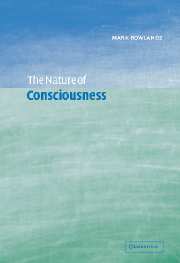Book contents
- Frontmatter
- Contents
- Preface
- 1 The problem of phenomenal consciousness
- 2 Consciousness and supervenience
- 3 The explanatory gap
- 4 Consciousness and higher-order experience
- 5 Consciousness and higher-order thoughts
- 6 The structure of consciousness
- 7 What it is like
- 8 Against objectualism II: mistakes about the way things seem
- 9 Consciousness and representation
- 10 Consciousness and the natural order
- Bibliography
- Index
4 - Consciousness and higher-order experience
Published online by Cambridge University Press: 22 September 2009
- Frontmatter
- Contents
- Preface
- 1 The problem of phenomenal consciousness
- 2 Consciousness and supervenience
- 3 The explanatory gap
- 4 Consciousness and higher-order experience
- 5 Consciousness and higher-order thoughts
- 6 The structure of consciousness
- 7 What it is like
- 8 Against objectualism II: mistakes about the way things seem
- 9 Consciousness and representation
- 10 Consciousness and the natural order
- Bibliography
- Index
Summary
The previous two chapters examined the mind–body problem, understood here as the attempt to explain consciousness in physical terms. More precisely, it examined two important attempts to argue that this could never be done. It was argued that these attempts were less than conclusive. In this, and the following, chapter, the focus switches to what is sometimes known as the mind–mind problem: the attempt to explain consciousness in terms of mental states and relations between such states.
HOR models of consciousness
‘Consciousness is the perception of what passes in a man's own mind.’ Thus wrote John Locke three hundred years ago. And the naturalness of this intuition has scarcely been eroded by the passage of time. Consciousness, we are tempted to assume, does not consist simply in an ordinary mental state or process, but rather in our awareness of such a state or process. The consciousness of a mental state or process is something added to it, something that becomes attached to the state or process by, or in virtue of, our standing in a certain relation to it, specifically, our standing in a relation of awareness to this state or process. This natural intuition receives its most recent expression in what are known as higher-order representation models of consciousness.
Higher-Order Representation (HOR) accounts of consciousness have, in recent years, been developed by, among others, David Armstrong (1981), Paul Churchland (1989), David Rosenthal (1986, 1990), Peter Carruthers (1996, 1998), and William Lycan (1987).
- Type
- Chapter
- Information
- The Nature of Consciousness , pp. 75 - 100Publisher: Cambridge University PressPrint publication year: 2001



